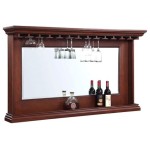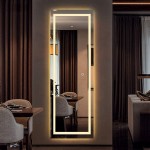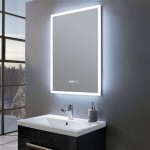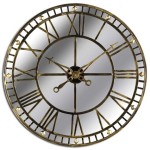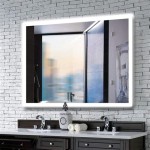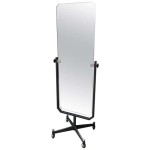Wood Circular Mirrors: A Guide to Style, Craftsmanship, and Selection
Circular mirrors, particularly those framed with wood, have become increasingly popular in interior design. Their versatility, combined with the natural warmth of wood, allows them to complement a wide range of aesthetic styles, from rustic farmhouse to modern minimalist.
The appeal of wood circular mirrors lies in their inherent ability to soften the often-harsh lines found in contemporary interiors. The circle, a symbol of unity and wholeness, introduces a sense of balance and harmony. Wood, with its organic textures and variations in grain, adds depth and visual interest, contrasting beautifully with the reflective surface of the mirror.
A key aspect of choosing a wood circular mirror is the type of wood used in its construction. Different wood species offer varying degrees of durability, color, and grain patterns. Oak, known for its strength and pronounced grain, lends a classic, timeless feel. Walnut, with its rich, dark hues, adds a touch of sophistication. Pine, a softer wood with a lighter color palette, provides a more casual, rustic aesthetic. Reclaimed wood, with its unique history and character marks, offers a sustainable and visually compelling option.
The finish applied to the wood frame significantly impacts the mirror's overall appearance. A natural finish highlights the wood's inherent beauty, showcasing its grain and color variations. Stained finishes allow for greater customization, offering a wider range of colors and tones to match specific décor schemes. Painted finishes, whether in bold, vibrant hues or subtle, neutral tones, provide a contemporary and versatile option. Distressed finishes, which mimic the wear and tear of age, contribute to a vintage or farmhouse aesthetic.
Beyond the wood type and finish, the size and scale of the mirror play a crucial role in its impact. Large wood circular mirrors can serve as striking focal points, creating a sense of grandeur and expanding the perceived space of a room. Smaller circular mirrors, particularly when grouped together, can add visual interest and create a sense of rhythm and repetition.
The width and profile of the wood frame also contribute to the mirror's overall style. Thin, minimalist frames lend a modern, understated elegance. Wider, more ornate frames, featuring intricate carvings or decorative details, contribute to a more traditional or bohemian aesthetic. The frame's profile, whether flat, beveled, or rounded, further enhances the mirror's visual appeal and tactile quality.
When incorporating a wood circular mirror into a specific room, it's essential to consider the existing décor and the desired atmosphere. In a bathroom, a wood circular mirror hung above a vanity can add warmth and sophistication. In a living room, a large wood circular mirror placed above a fireplace mantel can serve as a stunning focal point. In a bedroom, a smaller wood circular mirror hung above a dresser can create a sense of intimacy and personal style.
The placement of the mirror also influences its functionality and aesthetic impact. Hanging a wood circular mirror opposite a window can maximize natural light and create an illusion of greater space. Positioning a mirror near a light source can enhance the brightness and ambiance of a room. Grouping multiple wood circular mirrors of varying sizes can create a dynamic and visually engaging wall display.
Careful consideration of the mirror's hanging mechanism is also important. Traditional hanging hardware, such as D-rings and wire, offers a secure and versatile option. Alternatively, some mirrors may feature integrated keyhole slots or cleats for a more streamlined and contemporary look. Ensuring the mirror is securely mounted is crucial for both safety and aesthetic appeal.
The versatility of wood circular mirrors extends beyond traditional wall-mounted applications. Some designs incorporate shelves or hooks, offering practical storage solutions in addition to their reflective function. Others feature integrated lighting, providing both illumination and a decorative element. Exploring these multifunctional options can further enhance the practicality and visual appeal of the mirror.
The craftsmanship involved in creating a wood circular mirror is another important factor to consider. Handcrafted mirrors, often made by skilled artisans, offer unique character and attention to detail. These pieces may feature intricate joinery, hand-carved details, or unique wood finishes that elevate them beyond mass-produced alternatives. Investing in a handcrafted wood circular mirror supports skilled craftspeople and adds a touch of artistry to one's home.
Selecting the right wood circular mirror involves a careful evaluation of various factors, including the type of wood, finish, size, frame profile, and overall craftsmanship. By considering these elements in relation to the existing décor and desired aesthetic, one can choose a wood circular mirror that enhances the beauty and functionality of any space.

Acacia Wood Round Wall Mirror 40 Reviews Cb2

26 Classic Wood Round Mirror Natural Threshold Target

22 X Hutton Round Wood Wall Mirror Natural Kate And Laurel Target

30 Round Wood Framed Wall Mirror Natural Hearth Hand With Magnolia Target

Ashwood Round Wall Mirror Dunelm

Wood Frame Ledge Round Wall Mirror West Elm

Thin Wood Round Wall Mirror 30 West Elm

Selena Round Natural Wood Bathroom Mirror Wall Revvvd

Natural Wood Round Mirror Kirklands Home

Round Natural Beaded Wall Mirror Kirklands Home

